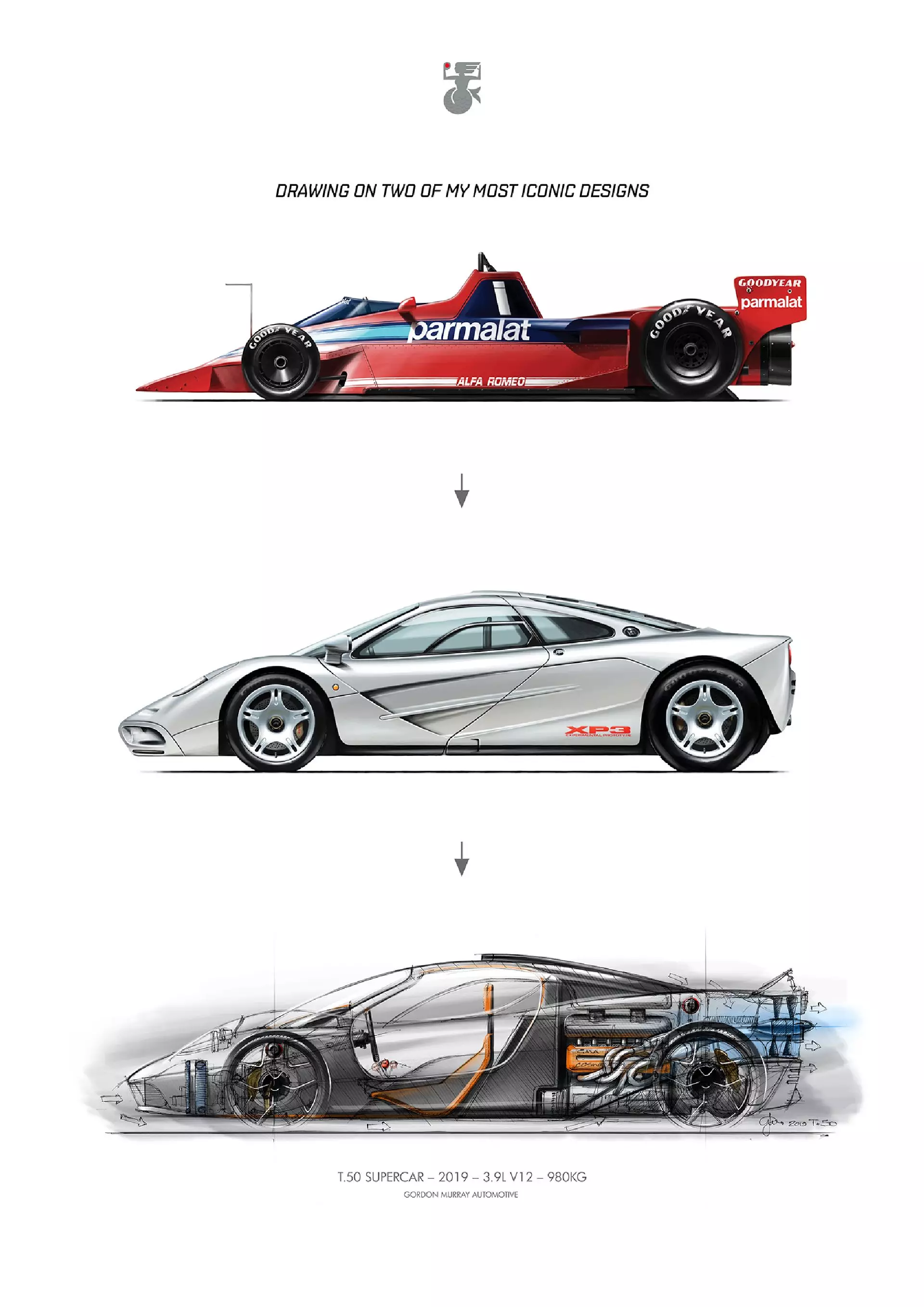McLaren unveiled the Speedtail, a hyper-GT that evokes the original McLaren F1, whether for its central driving position or the number of units to be produced, but a successor created on the same premises as the McLaren F1, only Gordon Murray, the “father” of the original F1, to do so.
Murray recently revealed what to expect from his new supercar (codename T.50), a true successor to the original McLaren F1, and we can only say it promises — we'll have to wait until 2021 or 2022 to see him definitively.
Don't expect to see a hybrid or an electric, as has been the norm lately, or an excess of electronic “babysitters” — in addition to the mandatory ABS, it will only have traction control; nor will ESP (stability control) be part of the repertoire.

The ultimate analogue supersport?
The T.50 recovers most of the premises and even features of the original McLaren F1. A car with compact dimensions — it will be a little bigger than the F1 but still smaller than a Porsche 911 — three seats with the driver's seat in the middle, a V12 naturally aspirated and placed longitudinally in the center position, manual transmission, rear-wheel drive and carbon, a lot of carbon fiber.

Gordon Murray doesn't want to chase records on circuits or top speed. Like McLaren, he wants to create the best road car possible, so the features of the T.50 already announced are sure to leave any enthusiast on weak legs.
The naturally aspirated V12 that the team is being made in collaboration with Cosworth — that same one, which in the Valkyrie's V12 gave us 11,100 rpm of pure adrenaline and atmospheric sound.
The T.50's V12 will be more compact, at just 3.9 l (McLaren F1: 6.1 l), but see the 11 100 rpm of the Aston Martin V12 and add 1000 rpm, with the redline appearing at 12 100 rpm(!).
There are no final specs yet, but everything points to a value around 650 hp, a little more than in the McLaren F1, and 460 Nm of torque. And all with a six-speed manual gearbox, to be developed by Xtrac, an option that, it seems, was a requirement of targeted potential customers looking for a more immersive drive.
Less than 1000 kg
The torque value seems “short” when compared to current supersports, usually supercharged or electrified in some way. No problem, because the T.50 will be light, even very light.
Gordon Murray refers only 980 kg , approximately 160 kg less than the McLaren F1 — lighter than a Mazda MX-5 2.0 — and dropping hundreds of pounds below current supersports, so the torque value doesn't have to be as high.

To stay under the ton, the T.50 will essentially be built in carbon fiber. Like the F1, both the structure and the bodywork will be made in wonder material. Interestingly, the T.50 won't have carbon wheels or suspension elements, as Murray believes they won't offer the durability a road car needs — however, the brakes will be carbon-ceramic.
Subscribe to our newsletter
More mass is saved on the T.50 by dispensing with aluminum sub-frames that would serve as anchor points for the suspension — double overlapping wishbones both at the front and at the rear. The rear suspension will be attached directly to the gearbox, and the front to the car's own structure. It won't be “scraping” the ground, with Gordon Murray promising usable ground clearance.
Wheels, too, will be more modest than expected — less static weight, less unsprung weight, and take up less space — when compared to other supermachines: 235 front tires on 19-inch wheels, and 295 rear wheels on wheels of 20″.
A fan to glue the T.50 to the asphalt
Gordon Murray wants a super sports car with clean lines, without the visual and aerodynamic apparatus of today's super and hyper sports. However, to achieve this, he had to rethink the entire aerodynamics of the T.50, recovering a solution applied to one of the Formula 1 that he designed in the past, the “fan car” Brabham BT46B.
Also known as “vacuum cleaners”, these single-seaters had a huge fan at their rear, whose function was to literally suck air from the underside of the car, gluing it to the asphalt, creating the so-called ground effect.
On the T.50, the fan will be 400 mm in diameter, will be electrically actuated — via a 48 V electrical system — and will “suck” the air from the underside of the car, increasing its stability and bending capacity, pasting him to the asphalt. Murray states that the fan operation will be active and interactive, being able to work automatically or controlled by the driver, and can be configured to generate high values of downforce or low values of drag.

Only 100 will be built
Development of the T.50 is proceeding at a good pace, with work on the development of the first “test mule” already underway. If there are no delays, the only 100 cars to be built will start being delivered in 2022, at an approximate cost of 2.8 million euros per unit.
The T.50, which should receive a definitive name in due course, is also the first car of the Gordon Murray Automotive brand, created nearly two years ago. According to Murray, this modern McLaren F1 will, he hopes, be the first of several models to bear the symbol of this new car brand.
